Atyopsis moluccensis, also called bamboo shrimp, are very interesting fresh water shrimp that feeds in a very special way and are not aggressive to the other aquatic pets. Proper preparation of the bamboo shrimp tank setup is critical to the health and survival of the species. In this article we’ll explain the basics of their native environment, what they eat, how to set up an appropriate habitat for them, and how to breed bamboo shrimp.
Content Table
Bamboo Shrimp Profile
Invertebrate animals known as bamboo shrimp, wood shrimp, or fan shrimp are freshwater crayfish crustaceans found in Singapore and other subtropical regions of Southeast Asia. They are commonly found in the slow-moving water of the rivers and streams with piles of organic matter, and they use their feathery branches in the shape of fans to siphon food from water particles.
Basic Information
Scientific Name: Atyopsis moluccensis
Habitat: Freshwater rivers and streams with strong currents
Size: Up to 3–4 inches (7-10 cm)
Lifespan: 1–2 years in captivity
Behavior: Peaceful, non-aggressive, and social, but can be shy.
Water Parameters: pH 6.5-7.5, temperature 72-82°F (22-28°C)
Special Features: Fan-like appendages for filter-feeding
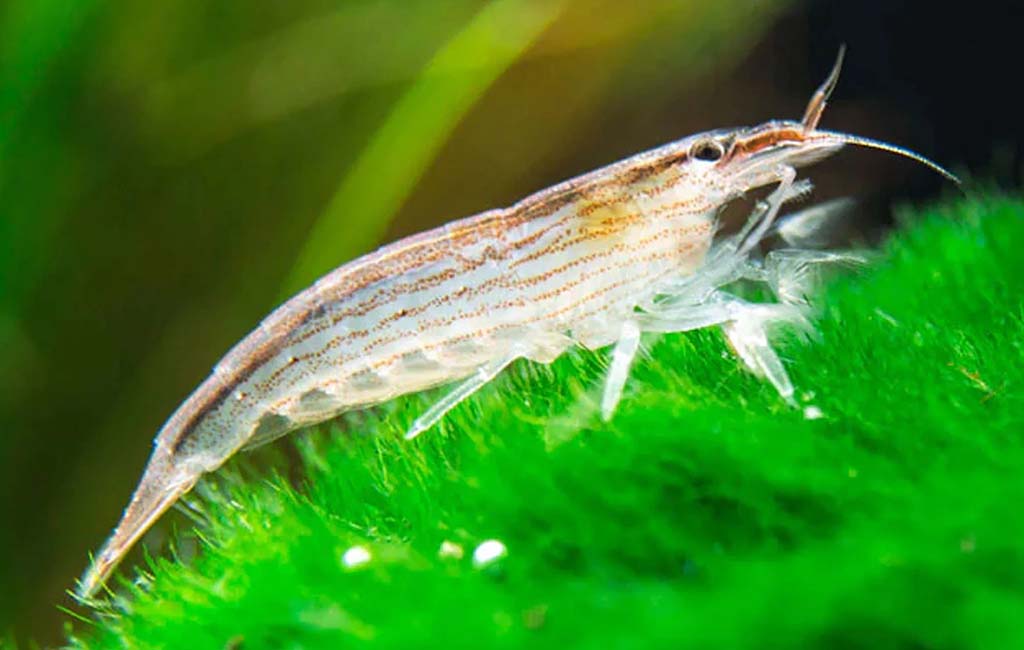
bamboo shrimp
Unique Traits and Behavior
Bamboo shrimp feed on bifidobacteria; they have adapted in the aspect that they depend on water flow to locate their prey on the water surface. They do not swarm around searching like regular shrimp, but rather anchor themselves where water currents are strong.
They use the thin ‘feet’ like fans of their front limbs to sweep in water for small animals, remains of other animals, and plants. Essentially, unlike many other freshwater shrimp, these animals have larval phases in brackish water in nature, which makes their breeding in captivity a great challenge.
They are very docile shrimp, therefore good for community tanks; however, they thrive well in a well-oxygenated and stable tank environment with appropriate filtration and water flow. Some of them are wild animals, and they have their own needs that should be met as they live in captivity.
What Do Bamboo Shrimp Eat
Unlike the scavenger shrimp, bamboo shrimp do not feed on the remains of the food that are found on the substrate. As for feeding, instead of having hooks, they possess the kind of fans that enable them to scoop tiny tracery from the water column.
Best Food Sources:
- Crushed fish flakes
- Microalgae
- Powdered shrimp food
- Infusoria
- Liquid fry food
To ensure they get enough food, target-feed them using a pipette or place food in areas with strong water flow.
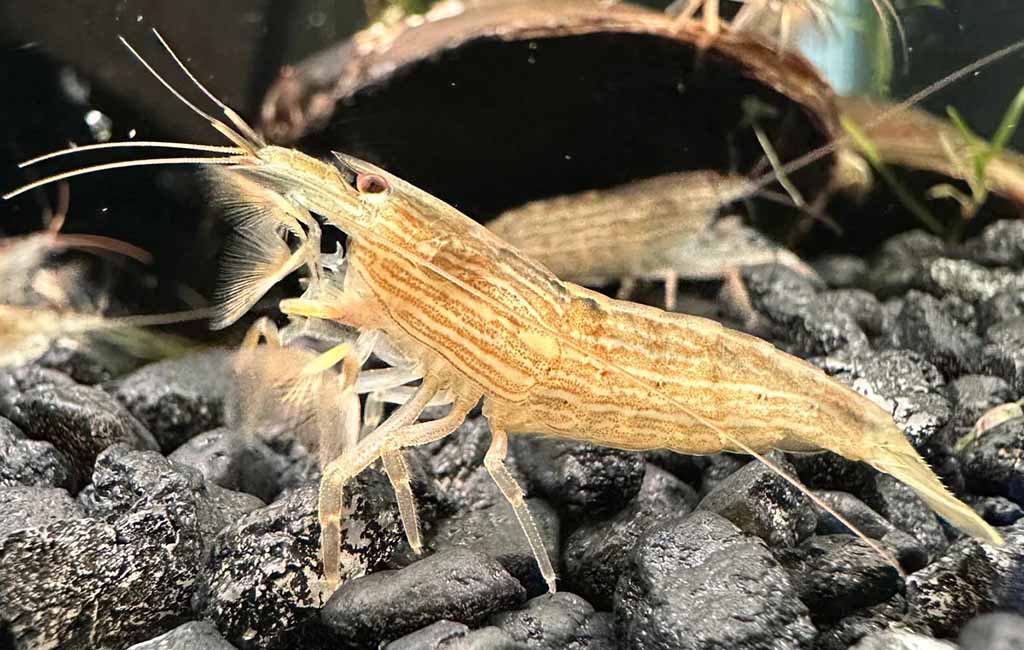
Bamboo Shrimp Change Color
Do Bamboo Shrimp Change Color
Yes! These organisms are naturally colored shrimp which has some kind of ability to alter their color, and it is not just for display. But it is indicative of their health, their surroundings, and even the food they feed on. Litophorin shrimp’s skin may be red-brown to green, but the color varies depending on the circumstances.
Why Do Bamboo Shrimp Change Color
- Stress & Water Quality: The shrimp changes the color to pale or dull type of colors if stressed due to poor water quality or sudden changes in the water conditions, or lack of food.
- Diet & Nutrition: It would be important to note that a healthy shrimp would appear to be more vibrant than a less healthy one; hence, when the shrimp is well-fed, it will be fully colored, and when it is a frail shrimp, it will be half colored or even less colored.
- Molting Process: After the molting period, some of the characters in the bamboo shrimp such as darkening and lightening may change as the shrimp shed off their exoskeleton and adapt themselves to the new one.
- Camouflage: Some shrimp use variations of shades to make it easier for them to feel safe in the tank.
Bamboo Shrimp Tank Size
Bamboo shrimp can have maximum length of 4 inches, which means the aquarium should provide enough space for its movements and hunting. Larger tanks give a more stable environment for water, which is requisite for filter-feeding shrimp.
Ideal Tank Size:
- For a single shrimp: 10 gallons
- For a small group (3-5 shrimp): 20–30 gallons
- For a larger colony: 40+ gallons
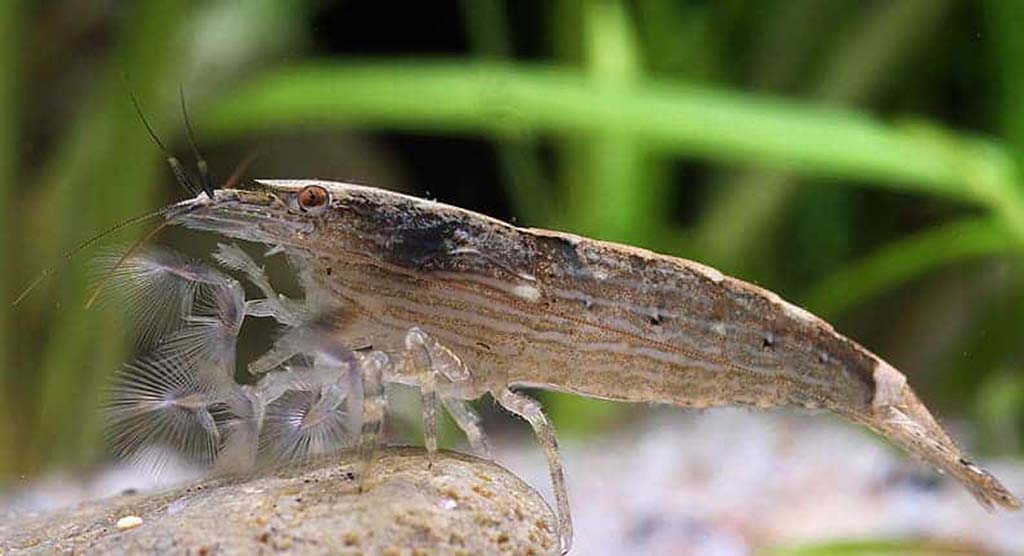
Bamboo shrimp tank setup
How to Set Up a Bamboo Shrimp Tank
Proper management of the living conditions is critical to the survival and optimal growth of bamboo shrimp. These shrimp are filter-feeders, meaning that water currents have to be provided in the tank in order to keep them healthy. See below some guidelines on how to create the fine bamboo shrimp aquarium.
Step 1: Choose the Right Tank
- It is good to use at least 20 gallons, although you would find that 30–40 gallons are ideal in case you wish to regulate the water conditions.
- A taller tank with ample vertical space is desirable, as it ensures better water flow that is mandatory for proper filter feeding among the shrimp.
Step 2: Install a Strong Yet Shrimp-Safe Filter
- It can best be treated with a simple ‘sponge filter’ or a ‘canister filter equipped with a flow control’. Remember not to use a strong filtration strength that might pull shrimp towards it.
- Adjust the output of the filter to flow in such a way as to maintain a slow, rhythmically-sustained water flow in which the shrimp can effectively filter feed without getting washed away.
Step 3: Choose the Right Substrate
- It is advisable to use sand or fine gravel at the bottom of the pond, since this supports the growth of beneficial bacteria that improve water quality.
- It is recommended to avoid sharp substrates, as bamboo shrimp do use the bottom occasionally.
Step 4: Add Plants and Decorations
- Java moss, Anubias, and hornwort are live plants that offer cover for a shrimp to hide and help to clean water through the absorption of excessive nutrients.
- They also provide crevice and ledges that can be used by shrimp to hold on to or orient itself to against the flow of water.
Step 5: Maintain Proper Water Flow
- The natural diet of the bamboo shrimp is to filter microscopic particles found in water thus, water flow motion should be slow and constantly flowing.
- To achieve currents, there is a need to employ filter outflows, tiny powerheads, or air stones in the desired areas of the tank.
Step 6: Cycle the Tank Properly
- Do not add shrimp immediately! This is because the tank must be cycled in order to avoid ammonia spikes.
- Before introducing shrimp, perform a nitrogen cycle, which might take four to six weeks. This would create ideal conditions for tests of beneficial bacteria that will help to regulate the water quality.
- Acclimatize the water values often in order to maintain stable conditions; Ammonia: 0 mg, Nitrites: 0 mg, Nitrates: less than 20 mg.
Bonus Tip: Acclimating Bamboo Shrimp
It is recommended to employ the drip acclimation method that lasts 1–2 hours when putting bamboo shrimp in the water to help them adapt since they will be transferred to different water conditions.
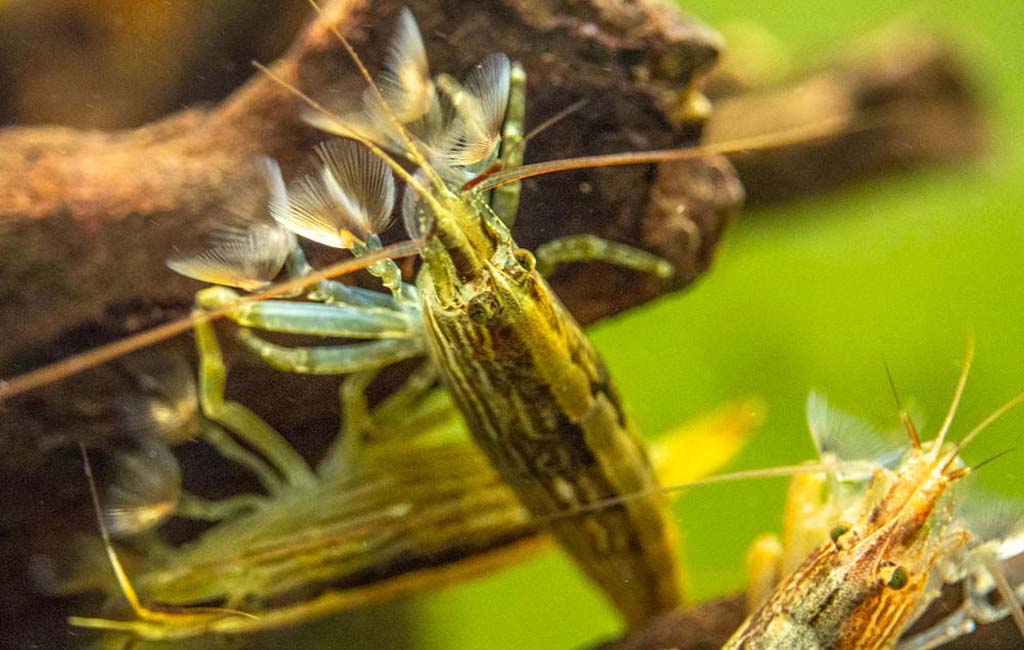
Bamboo shrimp tank size
Bamboo Shrimp Breeding
Bamboo shrimp (Atyopsis moluccensis) is one of the most difficult fish species to breed in captivity, primarily because they go through many stages in their growth. Unlike most of the freshwater shrimp, the bamboo shrimp go through a larval stage that can only survive in brackish water. This makes it almost impossible to farm them under normal home aquarium conditions.
Why Is Breeding Bamboo Shrimp So Difficult
- Egg Development
- Female bamboo shrimp bear numerous hundreds to thousands of minuscule eggs in their belly for approximately 30–40 days to hatch and become free-floating larvae.
- Unlike cherry shrimp or the Amano shrimp which hatch from eggs as tiny shrimps, bamboo shrimps do not hatch as juveniles but as larvae which are not fit for living in freshwater.
- Brackish Water Requirement
- Being semiaquatic, the larvae of the creatures end up in the shallow water of the brackish estuaries, where they grow up.
- It is impossible to reproduce such conditions in a home aquarium, whereas the concrete concentration of the salts (it should be 15-20 ppt) is vital for the young shrimp.
- Feeding Challenges
- The larvae are very strict feeders of the size of plankton, such as microscopic algae and rotifers, which may not be easily managed in an artificial environment.
- Despite the cases of specialized feeding, few of the larvae reach the post-larval stage in their life cycle.
- Metamorphosis & Freshwater Adaptation
- It is noteworthy that, if larvae do indeed develop in brackish water, they have to be gradually acclimatized to freshwater conditions.
- At this process, many aquarists faced osmotic shock—a sharp change in the concentration of water is dangerous for shrimps.
Has Anyone Successfully Bred Bamboo Shrimp
There are not many documented reports of the successful breeding of bamboo shrimp, although a few experienced aquarists have tried this. Almost all the husbandry of shrimp species sold for aquarium purposes, and this is due to the fact that it is very difficult to farm the shrimp commercially.
Concluding Remarks
Bamboo shrimps are fascinating and enjoyable to have in an aquarium, but at the same time, they are fragile creatures. Keeping in mind their water requirements, balancing their diet, and ensuring that the tank ambiance is properly arranged will ensure you can watch these shrimp for many years. Though breeding is not easy, proper care would help keep an active, healthy colony of shrimp.
It is however important to understand a number of factors concerning the bamboo shrimp so that it could indeed be a plus to your freshwater aquariums.
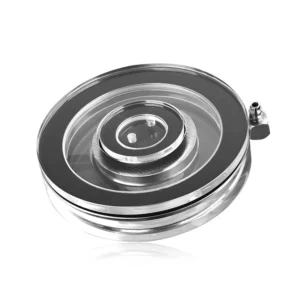
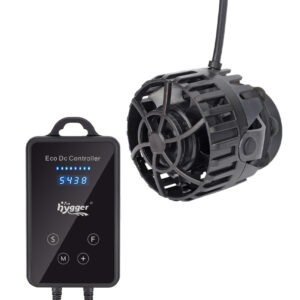
Leave a comment